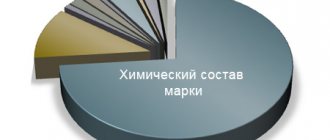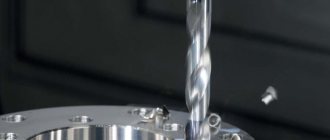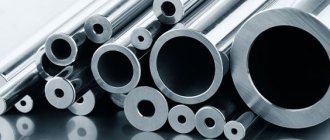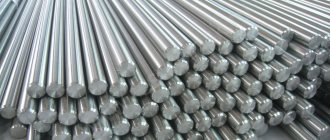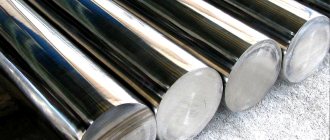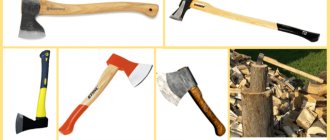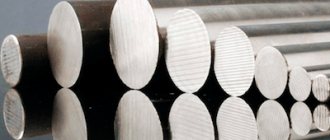Welding of stainless steels
In this article we will consider the welding technology of some alloyed chromium-nickel austenitic steels, namely: — corrosion-resistant steels (also known as stainless steel or simply “stainless steel”); — heat-resistant and heat-resistant steels. Welding technology of chromium-nickel austenitic steels. All procurement operations on austenitic steels, performed by cold or hot working methods, are carried out mainly by the same methods and on the same equipment as for carbon structural steels. Preparation of the edges of parts for welding must be done mechanically (milling, gouging, turning). It is allowed to prepare the edges with a compressed arc or gas-flux cutting, which requires subsequent mechanical cleaning of the fire-cutting edges to a depth of at least 0.8 mm. When assembling parts before tacking and welding, in order to avoid the formation of cuts and cracks on the surface of the base metal where molten metal splashes, areas near the seam must be covered with one of the types of protective coatings. In the manufacture of welded structures from austenitic steels, all methods of electric fusion welding can be used. The choice of welding method is made taking into account the thickness of the metal being welded, the size and shape of the structure, the location of the seams in space and their accessibility, requirements for welded joints, etc. The main feature of manual arc welding of austenitic steels is the need to ensure the required chemical composition of the weld metal for various types welded joints and spatial welding positions, taking into account changes in the share of the base and electrode metal in the weld metal. This forces the coating composition to be adjusted in order to ensure the required ferrite content in the weld and thereby prevent the formation of hot cracks in the weld. This also achieves the necessary heat resistance and corrosion resistance of the seams. By using electrodes with calcium fluoride coating, which reduces the loss of alloying elements, it is possible to obtain weld metal with the required chemical composition and structures. Maintaining a short arc without transverse vibrations of the electrode also helps to reduce the waste of alloying elements. The latter also reduces the likelihood of defects forming on the surface of the base metal as a result of the adhesion of splashes. The composition of the electrode coating determines the need to use direct current of reverse polarity (with alternating current or direct current of direct polarity, the arc is unstable), the value of which is determined by the formula Iсв=kde, and the coefficient k, depending on the diameter of the electrode, is taken to be no more than 25-30 A/mm. In the ceiling and vertical positions, the welding current is reduced by 10-30% compared to the current selected for the lower welding position. It is recommended to weld with coated electrodes using beads of small cross-section and to increase resistance to hot cracks, use electrodes with a diameter of 3 mm with minimal penetration of the base metal. Careful calcination of the electrodes before welding, the mode of which is determined by their brand, helps reduce the likelihood of the formation of pores and cracks caused by hydrogen in the seams. Some grades of electrodes recommended for various austenitic steels, depending on the operating conditions of the structure, are given in Table 1, and their mechanical properties are given in Table 2. Table 1. Some brands of electrodes and operating conditions for high-alloy steels and alloys| Electrode type | α-phase content (%) and weld structure | |||
| Corrosion-resistant steels | ||||
| 08Х18Н10 | Aggressive environments; resistance to intergranular corrosion | TsL-11 | E-04Х20Н9 | 2,5-7,0 |
| 12Х18Н10Т 08Х22Н6Т | Temperature up to 600oC; liquid media; resistance to intergranular corrosion | L38M | E 07Х20Н9 E-08Х19Н10Г2Б E-02Х10Н9Б | 3 — 5 |
| 10Х17НМ2Т 08Х18Н19Б 08Х21Н6М2Т | Temperature up to 700 °C; resistance to intergranular corrosion | SL-28 | E-08Х19Н10Г2МБ E-09Х19Н10Г2М2Б | 4 — 5 |
| 10Х17Н13МЗТ | Resistance to intergranular corrosion | NZh-13 | E-09Х19НУГ2М2Б | 4-8 |
| Heat-resistant steels | ||||
| 12Х18Н9 12Х18НУТ 08Х18Н12Т | Temperature up to 800 °C | TsT-26 | E-08Х16Н8М2 E-08Х17Н8М2 | 2 — 4 |
| 10Х23Н18 | Temperatures above 850 °C | OZL-4 OZL-6 | E-YUH25N13G2 | Over 2.5% |
| Heat-resistant steels | ||||
| 20Х20Х14С2 20Х25Н20С2 30Х18Н25С2 | Temperatures up to 900-1100°C Temperatures up to 1050°C; heat resistance and heat resistance | OZL OZL-9-1 | E-12Х24Н14С2 E-28Х24Н16Г6 | 3-10% Austenitic-carbide |
| Х25Н38ВТ ХН75МБТУ | Heat | EA-981-15 | E-09Х15Н25М6Г2Ф | Austenitic |
| Table 2. Typical mechanical properties at a temperature of 20 ° C of weld metal made on high-alloy corrosion-resistant and heat-resistant steels |
| Electrode brand | σт | σв | δ, % | KCU, J/cm3 |
| MPa/mm2 | ||||
| Corrosion-resistant steels | ||||
| TsL-11 | 360 | 600 | 24 | 70 |
| OZL-7 | 400 | 640 | 25 | 100 |
| L-38M | 300 | 600 | 30 | 90 |
| SL-28 | — | 600 | 38 | 120 |
| 11Zh-13 | 450 | 600 | 26 | 100 |
| Heat-resistant steels | ||||
| OZL-5 | 350 | 600 | 25 | 60 |
| OZL-6 | 350 | 570 | 33 | 100 |
| OZL-9-1 | 500 | 650 | 12 | 50 |
One of the main methods of welding high-alloy steels with a thickness of 3-50 mm, used in chemical, petrochemical equipment, nuclear engineering and some other industries, is submerged arc welding.
It has a great advantage over manual arc welding with coated electrodes due to the stability of the composition and properties of the metal along the entire length of the seam, when welding with and without groove edges. This is achieved by the absence of frequent craters formed when changing the electrode, arc breaks, uniform melting of the electrode wire and the base metal along the length of the seam (in manual welding, due to a change in the electrode extension, the rate of its melting at first will be less than at the end, which periodically changes the proportion of the base metal metal in the weld, and hence its composition) and more reliable protection of the welding zone from oxidation of alloying components by atmospheric oxygen. Good formation of the surface of the welds with fine scaling and a smooth transition to the base metal, the absence of splashes on the surface of the product significantly increases the corrosion resistance of welded joints. This method reduces the complexity of the preparatory work, since the cutting of edges is carried out on metal with a thickness of more than 12 mm (for manual welding, more than 3-5 mm). Welding with an increased gap and without cutting the edges of steel up to 30-40 mm thick is possible. Reducing losses due to waste, spattering and cinders of electrodes by 10-20% reduces the consumption of expensive welding wire. When welding under submerged arcs, it is much more difficult to ensure the required content of the ferrite phase in the weld metal only through the selection of welding fluxes and wires, which within the same brand have significant fluctuations in the chemical composition. The content of the ferrite phase in the metal is also affected by its thickness and different cutting forms, leading to a change in the proportion of the base metal in the weld metal. The technique and modes of submerged arc welding of high-alloy steels differ from welding of conventional low-alloy steels. To prevent overheating of the metal and the associated enlargement of the structure, the possibility of cracks and a decrease in the operational properties of the welded joint, it is recommended to weld with small cross-section beads, using wire with a diameter of 2-3 mm, and due to the high electrical resistance of austenitic steels, the electrode stickout should be reduced by 1.5-2 times.
The weld can be alloyed using flux (Table 3) or wire (Table 4), the latter is preferable, as it provides the necessary stability of the weld metal. Table 3. Fluxes for electric arc and electric slag welding of high-alloy steels
| Type of welding | Flux brand |
| Automatic electric arc austenitic-ferritic welds | ANF-14; ANF-16; 48-OF-Yu; K-8 |
| Automatic electric arc austenitic-ferritic welds with a small reserve of austenite | AN-26 |
| Automatic electric arc welding with purely austenitic welds with a large supply of austenite | ANF-5; FCC |
| Automatic electric arc and electroslag welding with purely austenitic welds with a large supply of austenite | 48-OF-6 |
| Electroslag with purely austenitic welds with a large supply of austenite | ANF-1; ANF-6; ANF-7; AN-29; AN-292 |
Table 4. Some grades of welding wire for submerged arc welding and electroslag welding of high-alloy steels
| steel grade | Working conditions | Wire grade (GOST 2246 - 70) |
| Corrosion-resistant steels | ||
| 12Х18Н9 08Х18Н10 12Х18Н10Т 12Х18Н9Т | Resistance to intergranular corrosion | Sv-0.1Х19Н9 Sv-0.4Х19Н9 Sv-07Х18Н9ТУ Sv-04Х19Н9С2 Sv-05Х19Н9ФЗС2 |
| 12Х18Н10Т 08Х18Н10Т 08Х18Н12Т 08Х18Н12Б | Temperature above 350°C; resistance to intergranular corrosion | Sv-07Х19Н10Б Sv-05Х20Н9ФБС |
| 10Х17Н13МЗТ 08X18Н12Б | Resistance to intergranular corrosion | Sv-08Х19Н10МЗБ; Sv-06Х20Н11МЗТБ |
| 08Х18Н10; 12Х18Н10Т 12Х18Н9Т | Welding in carbon dioxide; resistance to intergranular corrosion | Sv-08Х25Н13БТУ |
| Heat resistant steel | ||
| 12Х18Н9 | Temperature up to 800 °C | Sv-04Х19Н19 |
| 12Х18Н9Б 08Х18Н12Т | Temperature up to 800-900 °C | Sv-08Х18Н8Г2Б |
| Х15Н35В4Т | Heat | Sv-06Х19Н10МЗТ |
| Heat-resistant steels | ||
| 20Х23Н13 08Х20Н14С2 20Х23Н18 ХН35ВУ 20Х25Н20С2 | Temperature 800-900°C Temperature 900-1100°C Temperature up to 1200°C | Sv-07Х25Н13 Sv-07Х25Н12Г2Т Sv-06Х25Н12ТУ Sv-08Х25Н13БТУ Sv-08ХН50 |
For welding, low-silicon fluoride fluxes are used, which create non-oxidizing or low-oxidizing environments in the welding zone, which leads to minimal waste of alloying elements. To reduce the likelihood of pores forming in the welds, fluxes for high-alloy steels must be calcined immediately before welding at 500-800°C for 1-2 hours. Residues of slag and flux on the surface of the welds, which can serve as sources of corrosion of welded joints on corrosion- and heat-resistant steels , must be carefully removed. A feature of electroslag welding is its reduced sensitivity to the formation of hot cracks, which is explained by the low speed of movement of the heating source and the nature of crystallization of the metal of the weld pool, as a result, conditions are created for obtaining purely austenitic welds without cracks. However, prolonged exposure of the weld metal and heat-affected zone at elevated temperatures increases its overheating and the width of the heat-affected zone, and prolonged exposure of the metal at temperatures of 1200-1250°C leads to a change in its structure and reduces strength and plastic properties. As a result, welded joints of heat-resistant steels are prone to failure during heat treatment or operation at elevated temperatures. Overheating during welding of the heat-affected zone of corrosion-resistant steels can lead to the formation of knife corrosion in it, therefore, to prevent these defects, heat treatment of welded products (hardening or stabilizing annealing) is necessary. When choosing flux and welding wire, it is necessary to take into account the penetration of air oxygen through the surface of the slag bath, which leads to the loss of easily oxidized elements (titanium, manganese, etc.). This makes it necessary in some cases to protect the surface of the slag bath by blowing with argon. Electroslag welding of high-alloy steels can be performed with wire or plate electrodes (Table 5). It is advisable to weld thick products with short seams using a plate electrode; their manufacture is much simpler. But wire welding allows, within wide limits, by varying the mode, to change the shape of the metal pool and the nature of crystallization of the seam, and this is one of the effective factors ensuring the production of seams without hot cracks. Table 5. Typical mode of electroslag welding of high-alloy steels and alloys
| Metal thickness, mm | Electrode | Diameter, (dimensions), mm | Flux brand | Gap, mm | Electrode feed speed, m/h | Welding current strength, A | Voltage, V | Slag bath depth, mm |
| 100 100 200 200 | Wire Plate » » | 3 10X100 12X200 12X200 | ANF-7 ANF-7 ANF-1 ANF-6 | 28-32 28-32 38-40 38-40 | 330 2,4 1,9 1.9 | 600-800 1200-1300 3500-4000 1800-2000 | 40-42 24-26 22-24 26-28 | 25-35 15-20 15-20 15-20 |
However, the rigidity of the welding wire makes it difficult for long-term and reliable operation of the current supply and supply units of welding equipment. When welding in carbon dioxide, an oxidizing atmosphere is created in the arc due to the dissociation of carbon dioxide, causing increased (up to 50%) burnout of titanium and aluminum. Manganese, silicon and other alloying elements burn out less, therefore, when welding corrosion-resistant steels in carbon dioxide, welding wires containing deoxidizing and carbide-forming elements (aluminum, titanium, niobium) are used. The disadvantage of welding in carbon dioxide is the intense spattering of the metal and the formation of dense films of oxides on the surface of the weld, firmly adhered to the metal, which can reduce the corrosion resistance and heat resistance of the welded joint. To reduce the adhesion of splashes, emulsions are applied to the base metal, and to combat the oxide film, a small amount of ANF-5 fluoride flux is fed into the arc. Welding with a consumable electrode in carbon dioxide is carried out using semi-automatic and automatic machines. At the same time, for welding steel grade 12Х18Н10Тyu, Sv-07Х18Н9ТУ, Sv-08Х20Н9С2БТУ wire is recommended; for steel grades 12Х18Н12Т - wire Sv-Х25Н13БТУ, and for chromium-nickel-molybdenum steels - wire grades Sv-06Х19Н10МЗТ and Sv-06Х20Н11МЗТБ. Welding in carbon dioxide is carried out in all spatial positions, which makes it possible to mechanize welding work on structures made of high-alloy steels in installation conditions. Approximate modes of arc welding in carbon dioxide of high-alloy steels without cutting edges with a consumable electrode in carbon dioxide are given in Table. 6. Table 6. Modes of arc welding of high-alloy steels without cutting edges with a consumable electrode in carbon dioxide
| Metal thickness, mm | The seam | Wire diameter, mm | Electrode extension, mm | Urgent current strength, A | Arc voltage, V | Welding speed, m/h | Carbon dioxide consumption, l/min |
| 1 3 6 8 10 | Single-sided » Double-sided » » | 1 2 2 3 2 3 2 | 10 15 15 15 15 — 20 20 — 25 25 — 30 | 80 230-240 250-260 350-360 380-400 430-450 530-560 | 16 24-28 28-30 30-32 30-32 33-35 34-36 | 80 45-50 30 — 30 — — | 10-12 12-15 12-15 — 12-15 12-15 12-15 |
When welding in inert gases, the stability of the arc increases and the waste of alloying elements decreases, which is important when welding high-alloy steels.
Welding of austenitic steels in inert gases is performed with a non-consumable (tungsten) or consumable electrode. It is usually used for welding material up to 7 mm thick, but it is especially effective for small thicknesses (up to 1.5 mm), when burns are observed when using other methods. However, in some cases it is used when welding non-rotating butt pipes of large thickness, and welding root welds in grooves in the manufacture of particularly critical thick-walled products. Welding is carried out without filler material or with filler material using direct current of direct polarity. But when welding steel or an alloy with a high aluminum content, alternating current is used to destroy the surface film of oxides through cathode sputtering. Plasma welding is also used for high alloy steels. Its advantages are extremely low consumption of protective gas, the ability to obtain plasma jets of various cross-sections (round, rectangular, elliptical, etc.). It can be used for welding very thin metal thicknesses and for metal up to 12 mm thick. Approximate welding modes of high-alloy steels with a tungsten electrode at direct current of reverse polarity with filler wire with a diameter of 1.6 - 2.0 mm are given in Table. 7. Table 7. Modes of welding with a tungsten electrode in argon of high-alloy steels
| Metal thickness, mm | Connection type | Welding current strength, A | Argon consumption, l/min | Speed, m/h |
| Manual welding | ||||
| 1 2 3 | With flange | 35-60 65-120 100-140 | 3,5-4 5-6 6-7 | |
| 1 2 3 | Butt without groove with additive | 40-70 75-120 120-160 | 3,5-4 5-6 6-7 | |
| Automatic welding | ||||
| 1 2,5 4 | Butt without additive | 60-120 110-200 130-250 | 4 6-7 7-8 | 35-60 25-30 25-30 |
| 1 2 4 | Butt joint with additive | 80-140 140-240 200-280 | 4 6-7 7-8 | 30-60 20-30 15-30 |
Welding with a consumable electrode is carried out in inert as well as active gases or a mixture of gases. When welding high-alloy steels containing easily oxidized elements (aluminum, titanium, etc.), inert gases, mainly argon, should be used and the process should be carried out at current densities that ensure jet transfer of the electrode metal. Thus, when welding in argon, a butt joint is made on steel type 18-9 with a thickness of 5-6 mm at direct current of reverse polarity with a wire with a diameter of 1.2 mm at a welding current of 230-300 A, voltage of 16-20 V, gas flow rate of 16-20 V. 20 m/min, jet transfer of the electrode metal will take place. At the same time, the arc has high stability, and metal spattering is practically eliminated, which has a beneficial effect on the formation of seams in various spatial positions and eliminates the likelihood of the formation of corrosion centers associated with spattering when welding corrosion-resistant and heat-resistant steels. However, jet transfer in argon occurs at critical currents, when burn-throughs are possible when welding thin sheet metal. A decrease in the critical current can be achieved by adding 3-5% oxygen to argon, which reduces the likelihood of pore formation caused by hydrogen, or by using a mixture of argon with 15-20% carbon dioxide for welding, which reduces the consumption of expensive argon. But the presence of carbon dioxide can cause waste of alloying elements. An approximate mode of argon-arc butt welding with a consumable electrode of high-alloy steels in the lower position is given in Table. 8. Table 8. Mode of argon-arc butt welding with a consumable electrode of high-alloy steels
| Metal thickness, mm | Edge preparation | Number of layers | Welding wire diameter, mm | Welding power current, A | Welding speed, m/h | Argon consumption, l/min |
| Semi-automatic welding | ||||||
| 4 | Without cutting | 1 | 1,0-1,6 | 160-300 | — | 6-8 |
| 8 | V-cut | 2 | 1,6-2,0 | 240-360 | — | 11-15 |
| Automatic welding | ||||||
| 2 | Without cutting | 1 | 1 | 200-210 | 70 | 8-9 |
| 5 | V-groove at 50° angle | 1 | 1 | 260-275 | 44 | 8-9 |
| 10 | Same | 2 | 2 | 330-440 | 15-30 | 12-17 |
Characteristics of steel grade 08Х18Н10Т
| Standard | GOST 5949-75 - Graded and calibrated steel, corrosion-resistant, heat-resistant and heat-resistant. Specifications | |
| Application | Welded equipment operating in highly aggressive environments, heat exchangers, muffles, pipes, furnace fittings, electrodes of spark plugs; austenitic steel | |
Steel 08Х18Н10Т
belongs to the class of alloyed, corrosion-resistant, heat-resistant steels of the austenitic group.
Supplied in the form of long products and sheets, calibrated rods and forged blanks.
The main areas of application of steel 08Х18Н10Т
08Х18Н10Т
used for the manufacture of welded units and devices, the operation of which takes place in highly aggressive conditions; heat exchangers and muffles; pipeline products, furnace fittings, spark plug electrodes.
Steel marking 08Х18Н10Т
Explanation:
“
08
” indicates a carbon content of up to 0.08%, “
X18
” is the indicator of the introduction of chromium into the alloy in the amount of 18%, “
H10
” - determines the nickel content of up to 10%, the letter “
T
” at the end of the marking is the titanium content in the amount up to 1.0%.
Decoding 08Х18Н10Т
fully reveals the main indicators of steel.
The closest equivalents (analogues) of steel 08Х18Н10Т
| USA (ASTM/ASME) | 321, S32100 |
| Germany (DIN, WNr) | 1.4541, 1.4878, X10CrNiTi18-9 |
| Japan (JIS) | SUS321 |
| France (AFNOR) | 321F00, Z6CN18-10, Z6CN18-10 |
| England (BS) | 321S12, 321S18, 321S20, 321S22, 321S31 |
| Euronorms (EN) | 1.4541, X10CrNiTi18-10, X6CrNiTi18-10 |
| Italy (UNI) | X6CrNiTi18-11, X8CrNiTi1811 |
| Spain (UNE) | F.3523, X6CrNiTi18-10 |
| China (GB) | 0Cr18Ni11Ti, 1Cr18Ni9Ti, 0Cr18Ni10Ti |
| Sweden (SS) | 2337 |
| Poland (PN) | 0H18N10T, 1H18N10T, 1H18N9T |
| Czech Republic (CSN) | 17246, 17247, 17248 |
| Austria (ONORM) | X6CrNiTi18-10S, X6CrNiTi1810K, KW |
| Russia (GOST) | 10Х14Г14Н4Т, Х14Г14Н3Т |
What current should be used to cook with MMA?
For work, both alternating (transformer) and direct (inverter) current can be used, depending on the working conditions, the availability of equipment, and the choice of electrodes.
- On direct current. The best option, since the inverter allows you to precisely select all the parameters for high-quality welding. The amount of sprayed metal is minimal. Get an even, strong seam. The downside is the high cost of the equipment.
- On alternating current. The advantage is the much lower price of welding equipment. An experienced welder gets an equally high-quality weld. However, the volume of metal sprayed is usually larger. The consumption of the electrodes used is also somewhat higher.
Both options are now widely used on an industrial scale. Depending on the method, one or another special electrode is selected.
What electrodes should be used to cook stainless steel with ferrous metal?
Stainless and ferrous steels, as well as cast iron, have different metal structures and different expansion coefficients, which requires compliance with a number of conditions when welding.
Their weldability should be taken into account - the ability to form high-quality permanent connections in principle. It is also necessary to know the chemical composition of metals. The choice of welding materials depends on this. As a rule, electrodes made of high-alloy steels are used for welding:
- OZL-25B – for joining ferrous metals and heat-resistant steels;
- NIAT-5 – for austenitic steels;
- TsT-28 – for connecting steels with a large proportion of nickel to ferrous metals.
If it is not possible to identify the chemical composition, OZL-312 electrodes can be used. In this case, MMA is just one of the ways to join such metals. Non-consumable tungsten rods and gas (argon) welding are also widely used.
Application of steel 08Х18Н10Т taking into account characteristics and properties
Scope of use of steel 08Х18Н10Т
wide, just like the analogue 08Х18Н10Т – AISI 321 is in demand:
- Production of welded fittings and welding electrodes, spark plugs.
- Production of seamless stainless steel pipes using thin rolled metal.
- Production of parts and assemblies for the chemical industry - various containers, reservoirs, tanks, tanks, pipeline products, the working medium of which is alkaline and acidic liquids.
The main advantages of the alloy
Stainless steel grade 08Х18Н10Т is manufactured in accordance with the requirements of GOST 5632-72. It has high ductility, allowing it to easily produce thin-walled parts. When welding, it does not require preheating and subsequent cooling of the weld. The metal can be perfectly processed using any milling equipment.
Pots, pans and other utensils can be made from it. And due to the affordable price, the cost of such dishes turns out to be very affordable.
Physical properties
| Temperature, °C | Modulus of elasticity, E 105, MPa | Linear expansion coefficient, a 10 6, 1/°С | Thermal conductivity coefficient, l, W/m °C |
| 20 | 1,96 | — | — |
| 100 | — | 16,1 | 16 |
| 200 | — | — | 18 |
| 300 | — | 17,4 | 19 |
| 400 | — | — | |
| 500 | — | 18,2 |
Chemical composition in % of steel 08Х18Н10Т
| C | Si | Mn | P | S | Cr | Mo | Ni | V | Ti | Cu | W | Fe |
| <0,08 | <0,8 | <2,0 | <0,035 | <0,02 | 17,0-19,0 | <0,3 | 9,0-11,0 | <0,2 | <0,7 | <0,4 | <0,2 | Rest |
The chemical composition is the main thing on which the characteristics of steel 08Х18Н10Т depend.
The main element in the alloy is carbon, its content in this steel is 0.08%. To improve performance properties, chromium is added to the alloy - from 17 to 19%. The percentage of nickel is 9–11%. The alloy of this steel contains silicon, manganese and molybdenum in small concentrations - up to 0.9%. Titanium in an amount of 0.7% significantly changes the properties of steel 08Х18Н10Т.
The influence of chemical composition on the properties of steel
All properties of steel 08Х18Н10Т
, depend on the introduction of a sufficiently large percentage of chromium and nickel into the alloy. It should be taken into account that a high concentration of chromium significantly increases corrosion resistance. A large percentage of nickel has a negative impact on performance characteristics. Carbon, which is the main element, at low content can worsen hardness and strength, but increase weldability.
